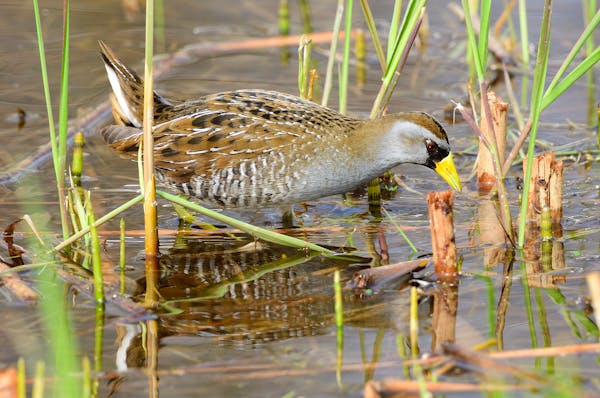Don Del Greco found a seat on a stump in the moonlit woods of Maplewood State Park at 4:30 a.m. in late April. He didn't have long to wait. By 4:45, song sparrows began singing and a barred owl made its last calls of the wee hours. By 5 a.m., robins joined the chorus, and then came what he really wanted to hear: the song of the yellow-rumped warbler.
"It was just amazing," said Del Greco, a lifelong birder and manager of the park. "It was the first flush of warblers we've seen."
Yellow-rumped warblers, which typically weigh less than two quarters, arrive after migrating thousands of miles from the southern United States. Other warblers have a more arduous journey, coming from as far as Brazil, Columbia and Costa Rica, and often flying farther north than Minnesota. They arrive in their brightest colors and sing their loudest songs for breeding season.
Peak numbers of songbirds should be passing through northwest Minnesota just in time for the Festival of Birds on May 19-22.
The festival has drawn all levels of birders from across the nation and Canada to Detroit Lakes since it began 19 years ago. It sparked the 200-plus-mile Pine to Prairie Birding Trail that was dedicated in 1999 and expanded into Manitoba in 2009, said Cleone Stewart, tourism director for the Detroit Lakes Regional Chamber of Commerce.
Minnesota's first birding trail ties together 45 areas along the intersection of three biomes: western prairie, eastern hardwoods and northern conifer forests. Close to 275 species converge along the corridor and are viewable within an hour's drive.
"You can lean one way and hear the veery thrush," said Del Greco of his 9,250-acre park where rolling woods abut waving fields of grass. "You lean the other way and hear the bobolink and meadowlark. It's a tug of war between forest and prairie."
Wetlands, potholes provide habitat
It takes only a drive northwest on Interstate 94 to see why the region stretching from Fergus Falls toward Detroit Lakes attracts birders. Vehicles roll past great blue herons and white egrets wading for dinner in the lakes and seasonal ponds called "prairie potholes" that flank the highway just past the Otter Tail County line. White pelicans circle like synchronized fliers as they search for a place to land.
"Those prairie potholes are so vital for our shorebirds," said Teresa Jaskiewicz, environmental education specialist with the Prairie Wetland Learning Center in Fergus Falls, Minn. She and the staff track the most recent sightings in the visitor center and offer tips on where to go for viewing.
The birding festival's close to 300 participants target different destinations each year, but typically include at least one trip to the learning center or other spots in the Fergus Falls Wetland Management District, which spans six counties and comprises close to 44,000 acres.
Besides a rich diversity of landscape, the birding festival offers a chance to celebrate Minnesota's success stories. Carrol Henderson, nongame wildlife program supervisor for the Minnesota Department of Natural Resources, will speak on the comeback of trumpeter swans that were down to 30 breeding pairs in the 1980s. The swans now are thriving at more than 1,500 breeding pairs.
"It's one of the most successful restorations the DNR's ever been involved with," he said. Henderson will also discuss ongoing research of the 2010 Deepwater Horizon oil spill's impact on loons that migrate to the Gulf of Mexico.
Loons and swans rank among spring's earliest migrants, needing to claim their turf — usually one pair of each per lake. The 42,700-acre Tamarac National Wildlife Refuge north of Detroit Lakes was instrumental in the swans' comeback, and the white birds stand out among the yellow grasses rimming more than 20 lakes and three river systems.
Kelly Blackledge, Tamarac's visitor services manager, turned down Bruce Boulevard where an osprey nest rises above the trees, and eagles are common. She showed where the staff had restored a young aspen forest that draws the golden-winged warbler. She can't wait to get her first glimpse of yellow feathers this season and hear the bird's distinctive zee-bee-bee-bee.
Roughly an hour south of the refuge, Del Greco will likewise keep tuned to the spring landscape for fresh arrivals.
"There's a whole parade of colorful migrants coming through every single day," he said.
Travel writer Lisa Meyers McClintick wrote "The Dakotas Off the Beaten Path" and "Day Trips from the Twin Cities."

Expect another year of roster troubles from the Wild. Here's why.
Fernando Tatis Jr. has 50 custom cleats planned this year, including odes to Gwynn, Curry and more

Meet the Athena Award winners: 103 female athletes honored by their schools

Can the Vikings find long-term running back solution in the draft?

